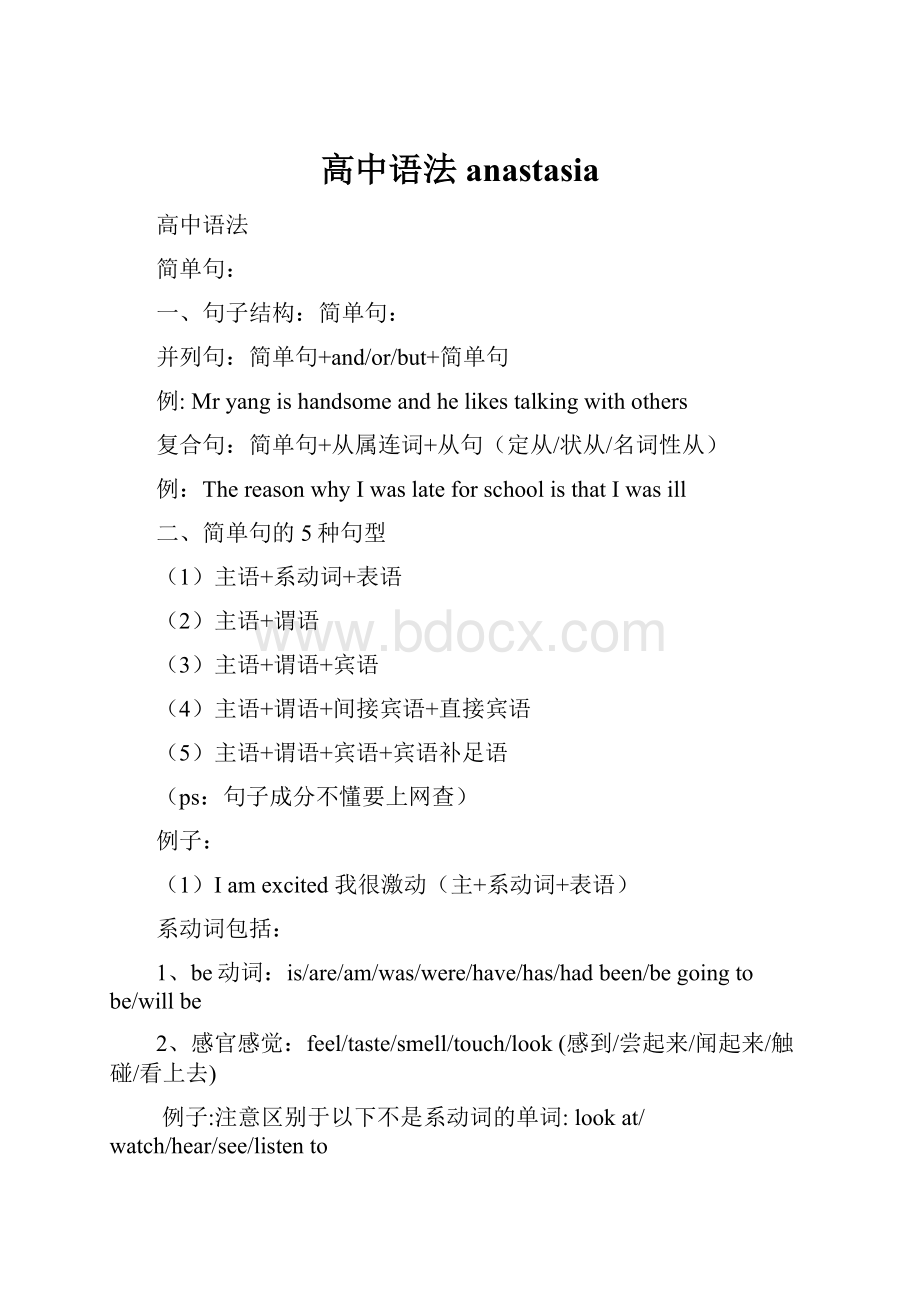高中语法 anastasia文档格式.docx
《高中语法 anastasia文档格式.docx》由会员分享,可在线阅读,更多相关《高中语法 anastasia文档格式.docx(36页珍藏版)》请在冰豆网上搜索。

Heappears(tobe)calm他看上去很平静
以下句型皆可换成Itseemthat……
一般现在时:
TheyseemtolikethesportItseemsthattheylikesport
完成时:
Theyseemtohaveknownthesecret他们看上去已经知道了那个秘密
发生顺序是先haveknown再seem,即:
先知道才表现出来
进行时:
Theyseemtobewatchingforsomebody
5、保持某种状态:
keep/stay/stand/remain
例:
Heremainsexcited
Itremainstobeseenthat……某事尚未得知
6、证明:
prove/turnout
(2)welaughed我们笑了(主语+谓语)
(3)Ireachedschool我到了学校(主+谓+宾)
(4)Myfatherboughtmealaptop我爸爸给我买了一个手提电脑(主+谓+间宾+直宾)
=Myfatherboughtalaptopformej
用forsb:
buy/make/do/find/cook/sing+forsb
用tosb:
give/send/teach/show/bring/write/lend/tell/promise/hand+tosb
(5)Hemakesmehappy他让我很高兴(主+谓+宾+宾补)
可作宾补的词:
名词/形容词/副词/动名词/不定式todo/介词短语/从句/-ed/-ing
非谓语动词:
定语:
1修饰名词代词的词
2表现形式:
adj(形容词)/分词/动名词/从句/adv(例如:
地点副词:
thegirloutside)/介词短语:
thestudentintheclassroom/名词appletree/名词所有格Lucy’room/数词
3位置:
前置定语,后置定语(特:
special只作后定)
状语:
修动词,形容词,副词,整个句子的词
verygood;
verymuch
状adj状adv
不能单独做谓语的动词
三种形式:
不定式todo,动名词+ing,分词:
现在分词+ing/过去分词+ed
主语(改错)
谓语
宾语(常考)
表语(改错)
定语(常考)
状语(常考)
宾补(常考)
不定式
todo
√
动名词
分词
功能
(一)非谓语动词作宾语
1、+todo(以下只加todo后缀)
Afford,agree,ask,beg,care,choose,decide,determine,dare,expect,fail,hope,learn,manage,need,offer,plan,prepare,pretend,promise,refuse,tend,want,wish
Youcanchoosetobeexcellent
2、+ing
Admit,appreciate,avoid,consider,delay,dislike,enjoy,escapt,excuse,feellike,finish,forgive,giveup,imagine,keep,mention,mind,miss,pracitse,putoff,resist,risk,suggest,tolerate,can’thelp,can’tstand,deny,envy……
3、两者都可接+todo或+doing
没多大区别:
一恨二开始三喜欢继续打算企图
Hate,begin/start,like/love/prefer,continue,intend,attempt
有大区别:
停止忘记后悔试图继续意味着情不自禁想起
Stop,forget,regret,try,goon,can’thelp,remember
stopdoing:
停止正在做的事stoptodo:
停止正在做的事去做另一件事
forgetdoing:
忘记做过某事forgettodo:
忘记要去做某事
regretdoing:
后悔做某事regrettodo:
遗憾的告诉你(do常为tell,inform,say)
trydoing:
尝试做某事(作建议)trytodo:
尽力做某事
goondoing:
继续做同一件事goontodo:
继续做另一件事
can’thelpdoing:
情不自禁做某事can’thelptodo:
不能帮助做某事
rememberdoing:
记得做过某事remembertodo:
记得要去做某事
4、allow
Permit+doing例:
wedon’tallowsmokingatschool
Advice+sbtodosth=wenotallowedstudenttosmoke
Forbid
5、sth+want/need/require+doing=tobedone
例:
ourclassroomneedscleaning=ourclassroomneedstobecleaned
6、{疑问词+todo}=主语、宾语、表语
Idon‘tknowwhattodonext=whattodonextisunknow
(二)非谓语动词作宾补
1、省略to的动词不定式作宾补(主动)
五看:
see,watch,lookat,notice,observe
后+sbdo三使:
make,let,have
两听:
listento,hear
一感:
feel
半个帮:
helpsb(to)dosth
例:
Iheardhimsingasong=Heisheardtosingbyme
Iheardhimsingingasong=Heisheardsingingbyme若前面的sing为ing形式,变式照抄ing
特:
have用作”使”的时候有以上用法,用作“有”时不是
Have的用法:
有:
have(sth)todo主语去做
Have(sth)tobedone主语让别人去做
使:
havesbdo、havesbdoing、havesthdone
Ihaveworkers……doing/done/do(使)
Ihavealettertodo/tobedone(有)
2、doing作宾补(主动)
后+sb+doing五看:
一使:
have
keep/leavesbdoing
sthdown
sorrytokeepyouwaitingsolong
findsbdoingsth
ifacookisfoundsmokinginthekitchin,
hewillbefiredatonce
catchsbdoing
撞上某人做某事
thesalesmanscoldedthegirlcaughtstealing
inthebookshopandlethergo
Smellsthburning
闻到什么被点着了
Set/sendsbdoingsth
setuslaughing
另外特殊的词:
3、+ed作宾补(被动)
后+sth三使:
+done两听:
Find,keep,leave,want,get
(三)非谓语动词作状语
1、分词作状语
主动
被动
与谓语动词动作同时发生
()+ing
()+ed
比谓语动词动作早发生
()+havingdone
()+havebeendone
状语在主语之前
hearingthisgoodnews,wecan’thelpjumpingwithjoy
Havingswitchedoffthetv,Iwantovermylessons关电视发生在over复习之前
被动Badlypolluted,thewatercan’tbedrunk
Havingbeencriticizedbyhegaveupsmoking
做题方法:
(1)分词的逻辑主语都是句子的主语
(2)考虑分词跟主句中的额主语是主动还是被动关系
hearingthisgoodnews,wecan’thelpjumpingwithjoy
即:
考虑we和hear的主动被动关系,是“我们听到”为主动关系,故hear加ing
状语在主句之后
伴随状语:
weenteredtheclassroom,talkingandlaughing
Thefamoussingersatthere,surroundingbyalotoffans
结果状语:
+ing自然而然的结果:
Asmallplanecrashedintoahillside,killing4peopleonboard
+todo意料之外的结果:
Ihurriedtoschoolonlytofindmybookleftathome
2、动词不定式todo作状语
(1)作目的状语to……
表“为了”inorderto:
可放句首,句中例:
Inordertomakemydreamscometrue,
Soasto:
可放句中Iworkhard
(2)作结果状语too……to例:
Heistooyoungtodresshimself
放句末so……asto
……Enoughto
Onlytodo常考(意料之外的结果,表“却”)
(3)作原因状语(考得少)Iamgladtomeetyou原因
特:
强调状态的固定搭配(系表结构作状语只用去掉be即可)
Belostin
bedressedat
befacedwith
beengagedto/in
bedeterminedto
beaddictedto
beknownfor
belocatedin
bearmedwith
berelatedto
beconcernedabout
bebasedon
beattractedto
……
……待补充
(四)非谓作定语
分词asleepingboy=aboywhoissleeping表示动作正在发生doing
asleepingbag=abagforsleep表示用途
Therasingsun=thesunwhichisrising表示动作正在发生
Therisensun=thesunwhichhasrisen表示被动/动作已完成+ed
过去分词作定语:
thequestiondiscussedyesterdayisveryimportant
Beingdiscussednow
Tobediscussedtomorrow
主动+ing
被动:
done过去/beingdone现在/tobedone将来
不定时todo作定语:
前有序数词时:
aroomtolivein
(五)非谓作主语:
+ing动名词/todo
1、playingtennisisveryintersting一个动名词用单数
Sayinganddoingaredifferent两个动名词用复数
2、seeingisbelieving/toseeistobelieve前后一致
3、readingaloudinthemorningisagoodhabit+ing是长期的,经常发生的,习惯性动作
Toswinintheriverisaninterestingexperiencetodo是一次性的,具体的
4、yourleavingearlymadeusunhappy+ing作主语,前面可以+one‘s,todo不行
5、It‘sno-use/nogood/ueslessdoingsth做……事没用/不好/没用固定句型only3
Thereisnoneedtodosth
thereisnoknowingwh-(what,where,why,when……)
thereisnoknowingwhetherhewillcome
(六)非谓作表语(很少考,一般在高考改错)
表示人的心理活动的词:
surprise,worry,excite,interest
+ing:
令人怎样的+ed:
感到怎样的
常修饰事物常修饰人
Thelittleboyfeltverytired
从句
一、定语从句:
(定语修饰n/代词/句子)~与名从的区别:
有先行词
(一)关系代词
缺少
主语
宾语(此时连词可省略)
定语
表语
指人
Who/which
Who(m)/that/介+whom
Whose+n/of+whom
That
指物
Which/that
Which/that/介+which
Whose+n/of+which
that
注:
1、在定从中:
地点where=介+which时间when=介+which原因why=forwhich
2、在非限制性定语从句中,把表格中的that去掉即可
在定语从句中,what永远不引导定语从句
Thisisthefamoussingerwhose/ofwhomnameiswell-knownallovertheworld
Heisnotthemanthat/whohewasbefore
3、做题步骤:
找出先行词,看是指人指物
看从句中缺什么成分
把先行词带到从句中检查,先行词充当什么成分就用相应的引导词
当先行词是人或物时,多注意从句的开头,若为名词则大部分情况下填whose充当定语,不填who/that/which
Thisisthefamoussingerwhosenameiswell-knownallovertheworld
(二)which,that的区别
只用that1、先行词为不定代词:
none,all,something……
(但当someone翻译为某人时用who)
2、先行词被序数词,最高级修饰:
themost,thefirst……
3、先行词有theonly,theright(正是,恰是),thevery,thelast。
Justthe(必背)
4、先行词有人又有物时
5、主语是以who/which开头的疑问句,为避免重复时
例句:
1、allthatcanbedonehasbeendone
3、youaretheonlyfriendthatIhave
4、weweretaklabouttheteachersandtheschoolthatwehavevisited
5、whoisthegirlthatisstandingoverthere
只用which1、非限制性定语从句当中
2、介词之后
(三)关系副词的用法
When:
November26isthedaythat/whichIwilltreasure(此处缺宾语)allmylife
Ican’tforgerthedaywhenIfirstmethim从句中什么都不缺
Where:
同上
Why:
thisisthereasonwhyIdidn’tcomehere从句中什么都不缺
Thereasonwhich/thatyougave(此处缺宾语)meisnotture
(四)特殊情况高考超重点
1、theway+that/inwhich/不加任何连词×
2、在英语中表示情况、场合的单词:
situation/case/point作先行词时,若从句中不缺少成分时,引导词用where
Idon’tlikethewaythat/inwhich/×
hespeakstome
Mostofuseventuallyfindourselvesinasituationwhereweorsomeonealsoneedshelp
(五)介词+which/whom(只有在定从中才有)
1、where=in/on/at……which
When=in/on/at……which
Why=forwhich
2、whose+n=the+n+ofwhich/ofwhich+the+n(指物)
=the+n+ofwhom/ofwhom+the+n(指人)
Thebeidgewhosesidesaredecoratedwithcolorfullightsisthefamous”YongRiverBrige”=thesidesofwhicharedevoratedwithcolorfullightsis……
Thereare47studentsinourclasswhosebackgroundsaredifferent
=thebackgroundofwhomaredifferent
3、介+which/whom的选择
(1),看从句中的动介/形介搭配
(2),看与先行词的搭配
herecommendedmeajobwithwhichIwasnotfamiliar
(familiarwithsth、familiartosb)
Therateatwhichtheforestaredestroyedhasincreased
(rate跟at搭配)
4、n/数词/pron(代词)+of+which(指物时)此结构常用作主语,常用在非限制性定从中
whom(指人时)
ourclassconsistof47students,mostofwhomareboys
recentlyIboughtacellphone,thepriceofwhicharereasonable
(六)AS引导的定语从句(只作主语,宾语。
表语)
1、限制性定从:
先行词thesame……as
Such……as
As/so……as
作主语DoyouwanttobuythesameTVaswasshowonTV
作表语状从:
Hewassuchagoodmanthatweallrespecthim此时不是定从,不能用suchas
定从:
Hewassuchagoodmanasweallrespect
2、非限制性定从
(1)as可以指代整个句子,可在句首/句中,翻译为:
正如,正像
AsweallknowChinaisplayingamoreandmoreimportantroleintheworld
定从先行词
Asisknowntoall:
as作宾语
(2)which引导非定只能放句中,且没有实意
二、名词性从句(主语从句,表语从句,同位语从句,宾语从句)
连接词
That
Whether/if
无义
是否
不充当成分,只起连接作用
连接代词
Who/whoever
Whom.whomever
What/whatever
Which/whichever
内容
选择
主